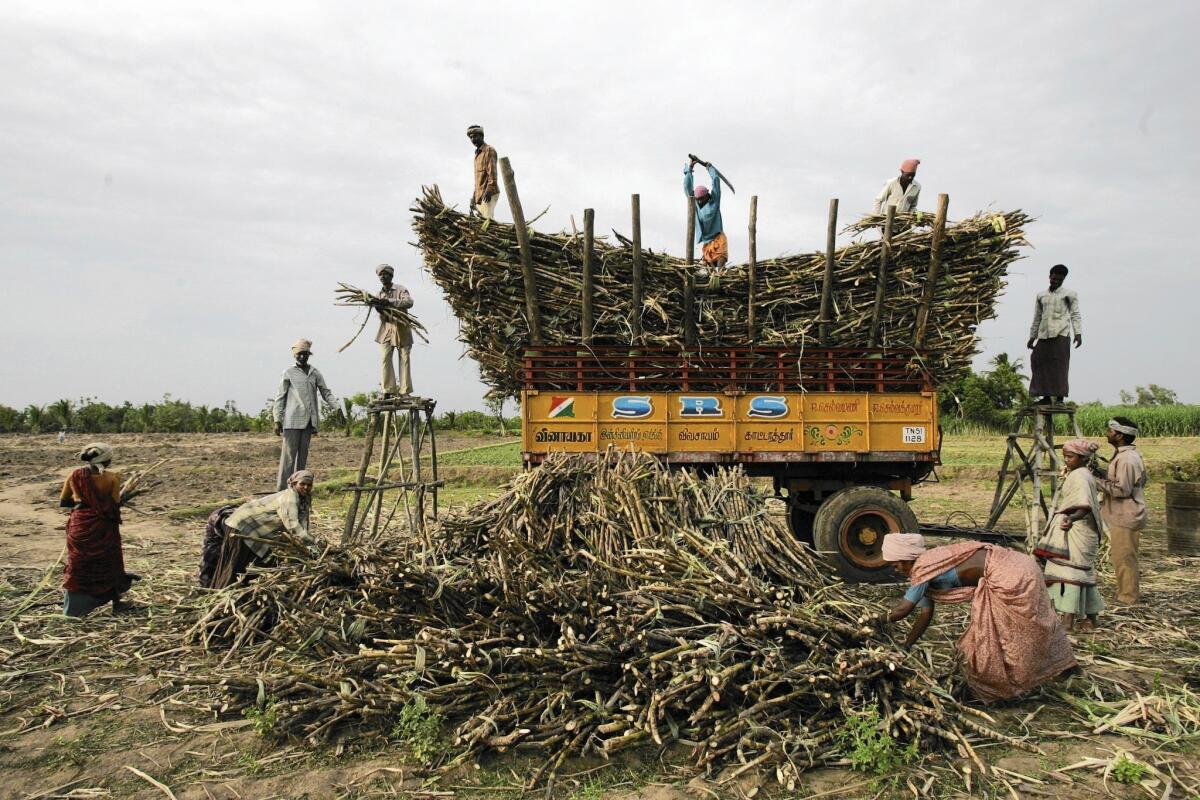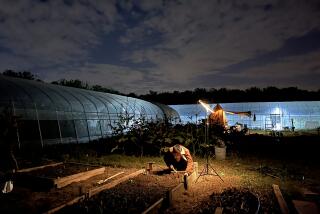In India, farm crisis drives villagers to become migrant laborers

Reporting from BODKHA, India — It shouldn’t be tough to run into a human being most anywhere in a country of 1.2 billion people. Yet in Bodkha village in western India, there is hardly anyone visible on a recent steamy afternoon.
The streets here are deserted not because families are taking siestas, but because nearly everyone has long ago left to find seasonal work several hours away.
“What are you looking for?” asks Nimbaji Tidke, 60, sitting under a tree outside his house, one of the few still inhabited in this parched village that normally claims about 2,000 residents. His two sons, Baburao, 32, and Hanumant, 27, are more than 300 miles to the south, toiling at a sugar cane factory along with their wives, leaving Tidke to look after his two young grandchildren.
A decades-long farm crisis in India, made worse by two successive years of drought, has accelerated a mass migration in the western state of Maharashtra, as able-bodied adults leave in search of work. Thousands of villages sit nearly empty for half the year, with only the young, old and infirm remaining behind.
This year has started ominously for Marathwada, a region in Maharashtra state. Ninety-three farmers committed suicide here in the first 45 days, according to government statistics. Last year, there were 569 farm suicides, up from 207 in 2013.
The state government has declared that almost 24,000 villages are suffering from drought this year. Eccentric weather patterns and a dearth of government aid have seen the agrarian crisis swell since the 1990s, forcing farmers to search for other modes of income.
“Successive droughts have rendered my 8-acre land almost useless,” says the mustachioed and white-bearded Tidke as he sits on a patch of barren earth outside his house. Combined with the effects of a hailstorm that devastated his cotton crop, he says, income, roughly $2,400 in a good year, fell by more than two-thirds last year.
Tidke, too, once worked as a laborer at sugar cane factories. “My body does not allow me now,” he says, pointing to his knees with a regretful smile. “I stay back with my wife, look after our two grandkids and tend to the livestock.”
More than 125,000 of the 2.5 million people in the surrounding Beed district have left home to become seasonal migrant laborers, according to a local official, Sanket Jadhav.
“Wells have run dry. We have been forced to sell off some of the livestock. How else are we supposed to recover the lost [income]?” Tidke asks. “It is not a matter of choice.”
In most cases, labor contractors hire the migrant workers, who have little say in where they are sent to work. Some have ended up at the Telgaon sugar cane factory on the outskirts of Beed, where the temporary homes of the migrant workers, small huts made of sugar cane and bamboo, occupy the periphery of the factory. Dried grass and trash are strewn about the area.
Laborers cook food at makeshift brick stoves under the open sky. Sanitation facilities are unhygienic, raising the risk of disease.
Jeeja Hangarge and his wife, Sulochana, traveled 75 miles to find jobs here. A contractor paid them a lump sum of about $1,300 for the six-month season. As a condition of employment, they must chop and load roughly 260 tons of sugar cane for their employer or risk having to pay back some of the money.
The couple, in their mid-30s, start their day at 4 a.m. and chop as much as 2 tons a day.
Sulochana, lean and weary-looking, hangs clothes to dry on a rope attached to her hut on her return from the field. The couple’s son Sagar, 7, and daughter Nikita, 12, emerge from the tiny, narrow entrance of their hut.
“My in-laws are frail, and most of the other relatives too are working at some sugar cane factory,” says Sulochana. “We had to take [the children] along.”
Back in Bodkha, the effect of migrant labor on children is apparent at the forlorn nursery school. Of 161 children registered, only 60 have been attending since October, teacher Rukmini Badhe says. At the nearby elementary school, one-third of the 65 students have been absent, having traveled with their parents because there was no one in the village to take care of them.
They are unable to enroll in classes where their parents are seasonal workers because schools are reluctant to accept students for less than the full academic year, activists say.
These children “suffer terribly,” says teacher Sheetal Kare. “When they return after spending months at the factory, we need to start from scratch. Their whole cycle is disturbed as they miss half the academic year.”
The situation stems from water shortages faced by farmers, says Vachista Bade, a political activist who runs a hostel in Beed district for the children of migrant laborers. Bade says local officials need to take serious measures to help farmers store water. Many have quit farming permanently and moved to Mumbai, Maharashtra’s largest city.
“They sweat in cities on a daily-wage basis and return to the village only during the annual monsoons,” says Ganesh Tidke, a Bodkha resident who works as a labor contractor and is unrelated to Nimbaji Tidke. “For a considerable number of farmers, farming has now become a secondary source of income.”
Migrant workers leave in October after the monsoon rains, their departure coinciding with Diwali, the Hindu holiday celebrated across India. Here, the annual “festival of lights” marks the start of desolation.
“I do not remember the last time I celebrated Diwali with my sons,” Nimbaji Tidke says as he helps his grandsons get ready for school. Asked whether the children miss their parents, he says, “Not really. They are used to it now.”
Parth M.N. is a special correspondent.
More to Read
Sign up for Essential California
The most important California stories and recommendations in your inbox every morning.
You may occasionally receive promotional content from the Los Angeles Times.










